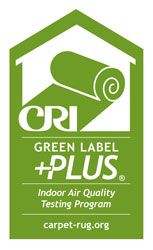Certified Low-Emission Carpet Adhesives and Carpet
Scope
In living spaces, utilize third-party certified low-emission carpet products that are designed to reduce human exposure indoors to individual VOCs. The How to Find Indoor airPLUS Compliant Low Emission Products document provides guidance on identifying compliant products including industry databases and examples of product labeling.
See the Compliance Tab for related codes and standards requirements, and criteria to meet national programs such as DOE’s Zero Energy Ready Home program, ENERGY STAR Certified Homes, and Indoor airPLUS.
Description
VOCs are emitted through off-gassing from many household products, including carpets and carpet adhesives. The How to Find Indoor airPLUS Compliant Low Emission Products document provides guidance on identifying compliant products including industry databases and examples of product labeling.
The Green Label Plus program tests carpets for emissions levels of 13 different chemicals, and tests carpet adhesives for 12 different chemicals. All Green Label Plus certified carpet and adhesives undergo a three-tier testing process, including follow-up testing to monitor continual compliance with emissions limitations.
As specified by the Green Label program, cushion products are characterized as prime polyurethane, bonded polyurethane, mechanically frothed polyurethane, rubber-hair, rubber–jute, synthetic fiber, resinated or coated synthetic fiber, rubber and rubberized polyurethane. Carpet cushions are tested for the following:
- total volatile organic compounds (TVOCs)
- butylated hydroxytoluene (BHT),
- formaldehyde,
- 4-phenylcyclohexine (4-PCH).
The maximum emissions limits for these are as follows:
- 1000 µg/m² hour for TVOCs,
- 300 µg/m² hour for BHT,
- 50 µg/m² hour for formaldehyde,
- 50 µg/m² hour for 4-PCH.
 Green Label and Green Label Plus are independent product certification programs run by the Carpet and Rug Institute (CRI). These certifications include third party verification to ensure products meet strict emissions limits. Each certified product is listed in the CRI certified products database, located on their website at www.carpet-rug.org.
Green Label and Green Label Plus are independent product certification programs run by the Carpet and Rug Institute (CRI). These certifications include third party verification to ensure products meet strict emissions limits. Each certified product is listed in the CRI certified products database, located on their website at www.carpet-rug.org.
 Using certified products lowers occupants’ risk of exposure to high levels of VOCs from construction materials. These Indoor airPLUS specifications can be implemented by requiring documentation of material certification for each material submittal package from sub-contractors. Any submittal requirements, such as manufacturer documentation of product certifications, should be clearly outlined in the project specifications and/or subcontractor bid package. Information for each third party certification and emissions standard required by Indoor airPLUS can be found in the How to Find Indoor airPLUS Compliant Low-Emission Products document.
Using certified products lowers occupants’ risk of exposure to high levels of VOCs from construction materials. These Indoor airPLUS specifications can be implemented by requiring documentation of material certification for each material submittal package from sub-contractors. Any submittal requirements, such as manufacturer documentation of product certifications, should be clearly outlined in the project specifications and/or subcontractor bid package. Information for each third party certification and emissions standard required by Indoor airPLUS can be found in the How to Find Indoor airPLUS Compliant Low-Emission Products document.
Ensuring Success
To ensure Indoor airPLUS Item 6.3 requirements are met, incorporate the requirements for product certification into the project’s specifications and/or bid package. Require documentation of product compliance for each product submittal from sub-contractors and suppliers.
Climate
No climate specific information applies.
Training
CAD Images
None Available
Compliance
Zero Energy Ready Home (Rev. 03) Exhibit 1, Item 6 “Indoor Air Quality” requires that builders meet the EPA Indoor airPLUS Verification Checklist and Construction Specifications.
The Indoor airPLUS Verification Checklist (Version 1 Rev. 03) states:
6.3: Carpets and Carpet Adhesives
- At least 90 percent of the interior surface area covered by carpet and carpet adhesives must use products labeled with, or otherwise documented as meeting, the Carpet and Rug Institute (CRI) Green Label Plus testing program criteria.
- For carpet cushion (i.e., padding), use only products certified to meet the CRI Green Label Plus or Green Label testing program criteria.
The How to Find Indoor airPLUS Compliant Low Emission Products document provides guidance on identifying compliant products including industry databases and examples of product labeling.
More Info.
Low/No VOC Carpets/Pads = Certified Low/No VOC Carpets
Alternate Terms
Sales Message


